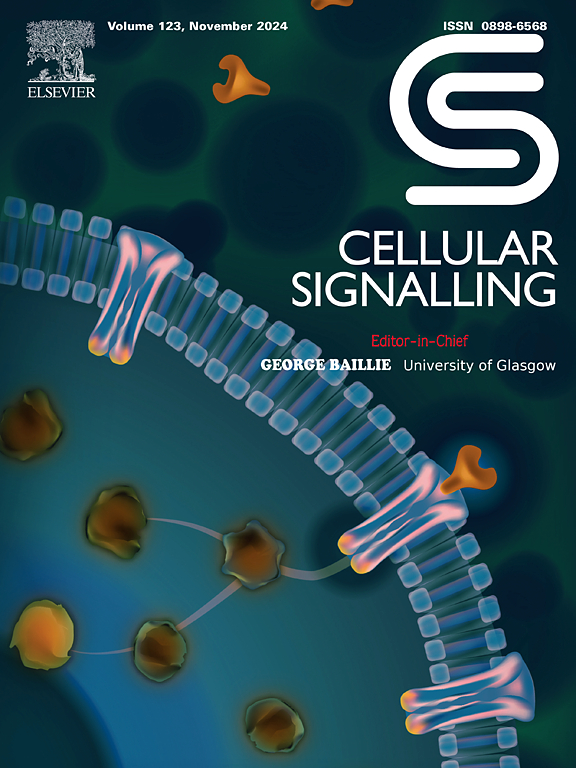AIM2 promotes the progression of HNSCC via STAT1 mediated transcription and IL-17/MAPK signaling
IF 4.4
2区 生物学
Q2 CELL BIOLOGY
引用次数: 0
Abstract
Chronic inflammation has been recognized as one of the hallmarks of head and neck squamous cell carcinoma (HNSCC), Absent In Melanoma 2(AIM2) has emerged as important regulators of chronic inflammatory, and participated in initiation, progression of kinds of human cancers. Nonetheless, the biological functions and underlying mechanisms of AIM2 in HNSCC remain inadequately understood. Based on the bioinformatics analysis of public databases, we identified elevated AIM2 expression in HNSCC, which positively correlates with disease stage and HPV infection, thereby possessing both diagnostic and prognostic significance. Immunohistochemistry on clinical samples revealed that AIM2 expression was frequently upregulated in cancerous tissues compared to paracancerous tissues, exhibiting a significant association with Ki-67 expression. Modulating AIM2 expression in HNSCC cell lines through transfection with inhibitors or mimics demonstrated that ectopic AIM2 expression enhances cell growth, migration, tumorigenesis, and metastasis both in vitro and in vivo. A dual luciferase reporter assay indicated that the transcription factor STAT1 can bind directly to the AIM2 promoter region and activate its transcription. The STAT1 inhibitor, fludarabine, reduces AIM2 expression and subsequently diminishes cell proliferation. Mechanistically, AIM2 exerts its tumor-promoting effects through the IL-17-MAPK signaling pathway. Collectively, our data demonstrate that AIM2, transcriptionally activated by STAT1, exhibits oncogenic functions by promoting the IL-17-MAPK signaling pathway, suggesting that AIM2 may be a new intervention targets for the diagnostic and treatment of HNSCC.
AIM2通过STAT1介导的转录和IL-17/MAPK信号传导促进HNSCC的进展。
慢性炎症已被认为是头颈部鳞状细胞癌(HNSCC)的标志之一,缺席黑色素瘤2(AIM2)已成为慢性炎症的重要调节因子,并参与各种人类癌症的发生、发展。然而,AIM2在HNSCC中的生物学功能和潜在机制尚不清楚。基于公共数据库的生物信息学分析,我们发现AIM2在HNSCC中表达升高,与疾病分期和HPV感染呈正相关,具有诊断和预后意义。临床样本免疫组化显示AIM2在癌组织中的表达比癌旁组织频繁上调,与Ki-67表达显著相关。通过转染抑制剂或模拟物调节AIM2在HNSCC细胞系中的表达表明,AIM2的异位表达在体外和体内都能促进细胞生长、迁移、肿瘤发生和转移。双荧光素酶报告基因实验表明,转录因子STAT1可以直接结合AIM2启动子区域并激活其转录。STAT1抑制剂氟达拉滨可降低AIM2的表达并随后降低细胞增殖。机制上,AIM2通过IL-17-MAPK信号通路发挥促肿瘤作用。总的来说,我们的数据表明,由STAT1转录激活的AIM2通过促进IL-17-MAPK信号通路表现出致癌功能,这表明AIM2可能是诊断和治疗HNSCC的新干预靶点。
本文章由计算机程序翻译,如有差异,请以英文原文为准。
求助全文
约1分钟内获得全文
求助全文
来源期刊

Cellular signalling
生物-细胞生物学
CiteScore
8.40
自引率
0.00%
发文量
250
审稿时长
27 days
期刊介绍:
Cellular Signalling publishes original research describing fundamental and clinical findings on the mechanisms, actions and structural components of cellular signalling systems in vitro and in vivo.
Cellular Signalling aims at full length research papers defining signalling systems ranging from microorganisms to cells, tissues and higher organisms.
文献相关原料
公司名称
产品信息
索莱宝
5× protein loading buffer
索莱宝
100× protease inhibitor cocktail
 求助内容:
求助内容: 应助结果提醒方式:
应助结果提醒方式:


